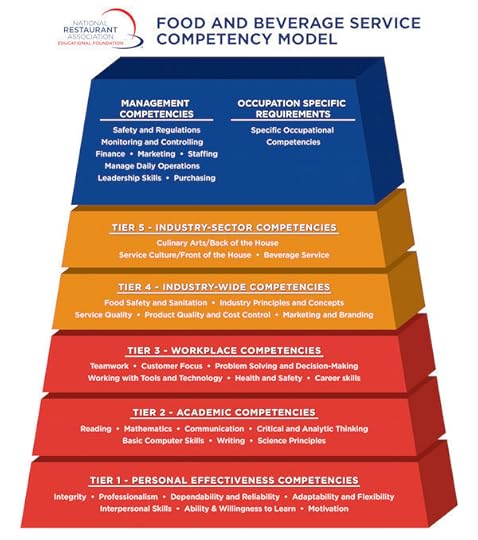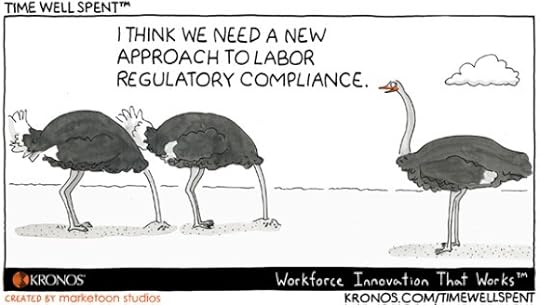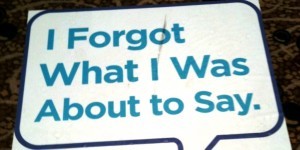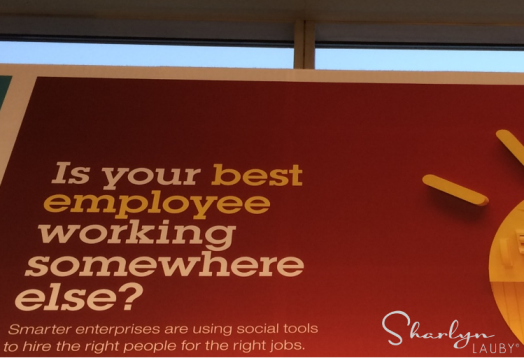Sharlyn J. Lauby's Blog, page 169
October 11, 2015
10 Performance Management Tips For the First Time Supervisor
Contrary to some media headlines, the performance appraisal isn’t dead and it’s not going away anytime soon. Yes, some organizations are announcing their plans to kill the performance review in favor of something else that doesn’t use the words “performance” or “appraisal”. But it will do kinda sorta the same thing. The process of giving employees regular feedback about their performance isn’t going away.
Why? Because deep down inside, we want regular feedback about our performance. “No news is good news” just isn’t a performance management philosophy. So it’s critical that supervisors learn how to deliver feedback. Whether you’re a first time supervisor or seasoned manager, here are 10 things to remember when it comes to employee performance reviews:
If your company offers performance appraisal training, take it. Evaluating performance and delivering feedback are skills that you will develop over time. Since this is a skill you will need for the rest of your career, go to training. And if the company doesn’t offer training, go to human resources and ask for it.
Understand the most common forms of rater bias. Some of the more common ones include leniency, recency, halo, horn and contrast. Knowing what rater bias is and how it can show up is the first step in keeping it out of the performance appraisal process.
Compare performance to the company standard. Speaking of contrast bias, there’s a reason that organizations develop standards. It’s to measure performance. Regardless of what your supervisor may have done over the years, you should never evaluate an employee’s performance against another employee.
Find a way to remember specific examples. When explaining performance, it’s very effective to use specific, behavior-based examples. No one expects a supervisor to remember in their head all the details of every single employee’s behavior. Meet with human resources and find out the best way to keep notes regarding employee performance. There are legal considerations, so be sure to discuss this matter with HR.
A performance appraisal should never be a surprise. Let me say that again – a conversation about an employee’s performance should not be a surprise. A supervisor should set performance expectations. They should have regular conversations about performance. The goal of performance management is to improve performance, not to shock people.
Get employees involved in the process. As a supervisor, you get time to think and prepare an employee’s performance review. Give the employee the same opportunity. Share a copy of their previous review, encourage them to do a self-appraisal, and schedule the performance review meeting in advance so they can gather their thoughts.
Performance feedback meeting logistics really are important. Remember to create the right atmosphere for this meeting. Choose the right room where you can have a private, frank conversation. Schedule it at the right time – not only allow for enough time to have the meeting but choose the right time of day. And if something goes kablooey on the day of the meeting…don’t be afraid to reschedule. Just tell the employee, “Hey today’s been really stressful for both of us. I want this conversation to happen when we’re both relaxed. Let’s reschedule it for later in the week.”
Talk about the past but focus on the future. I understand that there needs to be a certain amount of recap in a performance appraisal meeting. But rehashing the past can feel unproductive and possibly even painful. Everyone knows what’s happened in the past. A supervisor should spend the majority of time talking about the employee’s career in the future tense.
Ask about your performance. This is a great time to find out what you do well as a supervisor. Ask employees what you can do to support them. I recommend telling employees before the meeting that you’re going to ask this question so they can think about their answer. You’re giving them thoughtful feedback about their performance, allow them to do the same.
Don’t wait a year to have the next conversation. If you only have performance conversations once a year, it’s a tougher meeting. It takes more time to prepare, schedule, etc. etc. Regular performance discussions are not only easier to have but they benefit everyone involved.
I completely understand that the traditional performance appraisal needs a major revamp. But that doesn’t absolve us of our responsibility to give employees regular feedback about their performance. Regardless of the system you have or the process you use, employees want and expect good feedback. And if you’re a supervisor, it’s your job to provide it.
Image courtesy of Sharlyn Lauby
The post 10 Performance Management Tips For the First Time Supervisor appeared first on hr bartender.






October 9, 2015
Compliance Is a Part of Business – Friday Distraction
As human resources professionals, we see our fair share of compliance and legal issues. And there are plenty of people who want to pontificate that we’re not being strategic when we focus on compliance. Reality is, compliance and legal issues impact every aspect of business. It’s not just a human resources thing.
We can keep our “heads in the sand” where our obligations toward compliance are concerned. Sorry, couldn’t resist the pun. Our friends at Kronos understand this. Today’s Time Well Spent will make you smile.
Even issues like regulatory compliance involve a strategy. Our goal as human resources professionals is to be compliant within our corporate culture. That’s the challenge. To create strategy that’s both compliant and complementary isn’t an easy task.
How can we make that happen? Well, the first step is finding the right partners. Whether it’s your lawyer, consultant, freelancer or services provider, those individuals and organizations can help balance the need for compliance within the existing culture. Use them. Tap into their resources and expertise.
The post Compliance Is a Part of Business – Friday Distraction appeared first on hr bartender.






October 8, 2015
Use An “Ask Me Anything” (AMA) To Create Employee Engagement
Reddit (like many social platforms) is a social community where users can post text or links. One of its well-known features is called AMA which stands for “Ask Me Anything.” The Reddit community has interviewed politicians, comedians, and others asking them everything from their favorite condiments (Amy Poehler) to the chances of playing 007 (Idris Elba).
The reason I’m mentioning this feature is because I attended a conference several months ago where one of the speakers said that they do AMAs with their senior management team. It’s a great way to allow employees to interact with senior management. Let’s face it, senior management isn’t always available on orientation days. And their video on the onboarding portal sure is awesome but it’s not a substitute for human interaction.
An Ask Me Anything can be conducted at any time. The CEO is in Europe meeting with a potential client? They can still participate.
If you’re wondering how to conduct an Ask Me Anything session, here’s a resource from Mashable – How to Host a Successful Reddit AMA. Since your session will likely be internal, you might not be able to follow it literally but is should provide some creative inspiration.
Even if some employees miss the session, you can always promote the archive for later reading.
As human resources professionals, we need to draw creative inspiration from the activities around us. Like a social platform that has a very engaging activity, for instance. We can ask ourselves, “Would that work? Maybe we should try it out?” Organizations need to try new things to achieve new results.
Image courtesy of Sharlyn Lauby
The post Use An “Ask Me Anything” (AMA) To Create Employee Engagement appeared first on hr bartender.






October 6, 2015
Self-Management Success: Do Work You Enjoy (Part 2)
In the first post of this series on self-management success, I started a conversation about the trend toward self-management and the importance of giving employees the tools to be successful. I found this article on The Rouse titled “Why Self-Managed Teams are the Future of Business.” Very interesting read.
Here’s the takeaway: If self-managed teams are the future of business, then organizations need self-managed individuals. Of course, the first quality to successful self-management is knowing yourself. After that, it’s doing productive work.
The second quality to successful self-management is doing work you enjoy. There are many different ways to earn a living. Finding the way that’s right for you is key. We can spend years trying to figure out the right career. If you’re trying to figure out the kind of work you enjoy, here are two questions you can ask yourself:
Think about a time when you’ve felt you were at your most Then list what was taking place at that time – what were you working on, what was the office environment like, who were your co-workers, etc.
By contrast, do the same thing but identify the time when you’ve felt you were your least And what those elements were surrounding you at the time.
Now think of work on this continuum, with most productive on one end and least productive on the other.
Lastly, take a moment to assess where you are right now on this continuum.
As you make career decisions, it only makes sense to move toward being your most productive. Our careers aren’t single decisions. Most of us spend our entire lives changing and modifying our jobs to achieve that most productive state. The idea being, as we become more productive, we like our work more and the success associated with enjoying our work will come along with it.
Let’s add a layer to this conversation by saying you’re thinking about an upcoming meeting with your boss. Having a clear understanding of when you are most productive and least productive can help the conversation. You can talk about the work you’re doing in terms of being productive.
Another aspect of doing productive work is having the right environment. Using those same questions above, be sure you include on your most productive and least productive lists items such as equipment that helped you be productive or restricted you. This could be lighting, chairs, computers, desk space, whatever…
Being a successful worker is about being productive. Knowing the exact recipe for making that happen will help you maintain a high level of productivity no matter where you are.
The third quality on the self-management success list? Well as much as we know ourselves and our work, not everything can and will go as planned…look for problem-solving next.
Image courtesy of Sharlyn Lauby
The post Self-Management Success: Do Work You Enjoy (Part 2) appeared first on hr bartender.






October 4, 2015
Ambitious But No Opportunities Available – Ask #HR Bartender
This is a long reader note, but one I think you’ll find interesting. My guess is there are many employees who feel this way, whether it’s their first job or the fourth.
Hi Sharlyn. I read your blog post about succession planning and I’m really interested in what advice you may have for me. This is my first real career job since graduating from college and it’s wonderful. However, the turnover at my company is incredibly low. I’ve been here for almost three years and I am still the newest person in my department. There doesn’t seem to be anywhere for me to go in the next several years and I’m becoming very restless in my current position.
I’m far more educated than anyone else I work with. I also have a lot of volunteer and board experience when I was involved with student activities in college. In trying to fit in with everyone, I very rarely even mention my time in college and I’ve never told anyone that I was student leader or any of that. I don’t want to make anyone feel belittled or look like I’m bragging.
However, my ambitions are incredibly high and I’m starting to lose patience that I’ll be able to work my way up in the company. I could look elsewhere for a job with more career growth potential, but I feel that I would have to start over in entry-level if I did that. My salary would surely be half of what it is now or less, which I couldn’t live on. I’m sorry about the lengthy description of my situation, but I’ve lost a lot of sleep over this lately and a lot of time dwelling on it.
I’ve wondered if it would be so terrible for me to just go speak with the HR manager and explain my thoughts and feelings. How can I explain in a polite, collaborative way that I am overqualified and underappreciated in my current role in many ways, and I’m ready to start working toward a promotion? Thank you!
There are so many things we don’t know about this situation that it would be unfair to give one piece of advice. But there are some things to consider:
No one can ever take education away from you. I do understand how frustrating it can be to want a promotion or a position of greater responsibility and it’s just not moving fast enough. But there are steps you can take while you’re waiting for the opportunity to arise. The biggest being training. Look for opportunities to learn by taking a class or volunteering for a special project.
There are lots of different kinds of smart. Yes, going to college and getting a degree is awesome. And people who accomplish this should be proud. This doesn’t mean we don’t have lots to learn. One of the topics that’s very difficult to teach in school is office politics and relationship building. Use this time to develop those types of skills that you will need for the rest of your career.
Opportunities exist everywhere. Making the decision to change jobs can be scary. No one says if you listen to a headhunter that you must go on an interview. And no one says if you go on an interview that you must take the job. Be open to other opportunities – both inside the organization as well as outside. The important part is knowing exactly what you’re looking for and being able to articulate it.
Going to HR is not a substitute for speaking to your manager. Yes, by all means you can go to human resources. The question becomes what would you say? And more importantly, how do you have that same conversation with your supervisor? Because at some point, you will have to speak with your supervisor about the situation.
As you can see, there are many things to consider before approaching HR or your manager about your career. On the flip side, organizations need to be aware that this isn’t new thinking. Nor it is “Millennial” thinking. Over the last few years, there are people who have been patiently waiting for their next opportunity. Activities like training, professional development, mentoring, coaching, etc. are ways to keep talent engaged with the organization.
In order to retain top talent, managers need to start having conversations with employees about how they can enhance their career without a promotion. Otherwise, another company is going to offer them the job they’re looking for.
Image courtesy of Sharlyn Lauby
The post Ambitious But No Opportunities Available – Ask #HR Bartender appeared first on hr bartender.






October 2, 2015
Competency Models Provide the Roadmap for Career Success – Friday Distraction
Editor’s Note: Today’s post is brought to you by our friends at the National Restaurant Association Educational Foundation (NRAEF) . As the philanthropic foundation of the National Restaurant Association, the NRAEF works to attract, develop and retain professionals for the restaurant industry. Enjoy today’s post!)
I recently answered a reader question about developing HR competencies. If you missed the post, you can check it out here. The thing we have to keep in mind when talking about competencies is that they not only represent our current jobs but the roles we want to have in the future. For that reason, employees need to understand how to read competency models.
Take as an example the Food and Beverage Service Competency Model developed by National Restaurant Association Educational Foundation (NRAEF). The model profiles the employability and technical skills essential to achieving life-long career success in the industry. It’s now represented as part of U.S. Department of Labor Employment and Training Administration’s Industry Competency Model Initiative.

The NRAEF model shows that the restaurant industry can be a good place to begin and chart a life-long career. Here are a couple of stats to support the point:
86 percent of employees at table service restaurants and 85 percent of employees at limited-service restaurants say they have advanced to a higher-paying job in the industry.
90 percent of individuals in business operation positions have advanced to higher-paying jobs in the industry, as have 88 percent of chefs and cooks.
It’s also possible that a start in the restaurant industry could lead to entrepreneurship. 80 percent of employees and 90 percent of owners believe the restaurant industry is one where people of all backgrounds have the opportunity to own their own business.
Competency models provide the roadmap for career success #ChooseRestaurants
Click To Tweet
Competency models not only tell us about the skills we need today (like knowledge and personal effectiveness) but the ones we will need in the future (such as finance, marketing, and staffing). As human resources professionals, we want to make sure that employees understand the competency models for their profession/industry and know how to read it for the long-term. The roadmap for career success lies in competency models.
The post Competency Models Provide the Roadmap for Career Success – Friday Distraction appeared first on hr bartender.






October 1, 2015
Servant Leadership: Turning Hierarchy Upside Down
“To be an excellent leader, you have to be a superb follower.” – Herb Kelleher, former CEO of Southwest Airlines.
If you’re not following Josh Bersin’s writings, you should be. He’s written a couple of posts lately that deserve discussion. The first is on Forbes, and it’s titled “Culture: Why It’s the Hottest Topic in Business Today” and it addresses the employee engagement and retention crisis facing organizations. The second is on his blog, “A New Market is Born: Employee Engagement, Feedback and Culture Apps.”
My takeaway from his recent work is that organizations need to examine their leadership. Yes, organizations need to develop and maintain an excellent culture. They need to engage and retain their employees. And it’s perfectly OK to use technology tools and apps to facilitate the conversation. But none of it can happen without leadership.
In fact, let me take it one step further and say none of it will happen without using some of the qualities found in servant leadership. I learned about servant leadership years ago when I participated in a program called Leadership Broward. The program was designed to encourage business leaders to become active community stewards. Servant leadership was one of the concepts shared during the program.
To give you a little history, servant leadership was started in the 1970’s by Robert Greenleaf, director of management research at AT&T. Greenleaf’s job was to study how the best leaders emerged in organizations. During the same time, Greenleaf was personally troubled by the student unrest found on college and university campuses.
Greenleaf decided the best way to understand the youth movement and what was happening in society was to read a novel that was very popular with youth at the time. The novel was “Journey to the East” by Hermann Hesse.
SPOILER ALERT: “Journey to the East” is about a group of people traveling to a new land. Accompanying the group is their servant, Leo, who sings songs and takes care of their stuff. During the trip, Leo disappears. The group struggles to stay together and eventually disbands. Several years later, it’s discovered that Leo – the group’s servant – was really their leader.
Inspired by Leo’s character, Greenleaf realizes the key to leadership lies in “serving” (i.e., focusing on the people you manage) and writes what’s considered to be his most famous essay, “The Servant as Leader”, outlining 10 qualities associated with servant leadership. Here are a few of them:
Leaders are committed to developing others and helping them become good leaders.
Leaders not only empathize with others, but accept them for who they are.
A leader responds to a problem by listening first.
Leaders conceptualize and articulate a clear vision with passion, which engages and energizes the rest of the team.
Leaders have foresight and use good decision making skills.
Leaders open the doors of perception and become self-aware.
Greenleaf’s writings have been criticized over the years, but in reading his words, I find it amazing that over thirty years later, many (if not all) of the characteristics are still associated with leadership. Maybe they’re not called by the same name, but the traits are similar. Earlier this year, in my interview with Dr. Ken Blanchard, he shared his take on servant leadership:
“In fact, I am a big fan of servant leadership. I think vision and direction is the leadership part of servant leadership and operational leadership is the servant part of servant leadership. Vision and direction has to come from the top of the hierarchy. That doesn’t mean you don’t allow people to participate in formulating the vision, but the responsibility for establishing the vision lies with the hierarchy. Once people know where they’re going, then you have to turn the hierarchical pyramid upside down. Now you as the leader serve your people by helping them implement the vision.”
There’s no magic formula to being a good leader. But if there was, serving the people you work with every day has got to be a big part of it. It’s also what it takes to engage and retain talent within your organizational culture.
Image courtesy of Sharlyn Lauby
The post Servant Leadership: Turning Hierarchy Upside Down appeared first on hr bartender.






September 29, 2015
Employer Sends Invoice to Former Employee – Ask #HR Bartender
Based on the title, you might think today’s reader question seems like a one-in-a-million situation. The thought crossed my mind too. But after thinking about it, overpaying employees is a serious issue.
Hi Sharlyn. I currently work as a manager at a nonprofit organization. Before this job, I worked in the government sector from 2006 to 2010. I left in 2010 because of an illness.
I recently received a letter from the finance department of my former employer stating that they overpaid my sick leave benefits during my course of employment and I owe them $18,500. I was never informed that I didn’t have enough sick leave.
What are my rights in this case? Should I contact a lawyer or human resources? I tried to contact the finance department. They just don’t want to deal with me and haven’t answered any of my emails. I really can’t add this stress to my life. Thanks in advance for your help.
It won’t surprise you that this is one of those times when you need to reach out and consult with your friendly employment attorney. I’m delighted that Kate Bischoff, JD, SPHR, with the firm of Zelle Hofmann offered to answer a few questions. She helped us with this issue recently.
Please remember that Kate’s comments should not be construed as legal advice or as pertaining to any specific factual situations. If you have detailed questions, they should be addressed with your friendly labor attorney.
First off, the employee has been gone from the company for five years. Does an organization have the right to ask for the money back after so much time has passed?
[Kate] Government employers have their own set of rules, but it is possible that a public employer could seek recovery for an overpayment after five years. Private employers may not have as much time. Each state has its own statute of limitations for breach of contract or wage claims. Generally, private employers do not have five years, but it would depend on the state where the employer does business and where the employee resides.
I know that companies do accidentally overpay employees. But $18,500?! That’s a huge overpayment. Are there measures that companies can put into place to make sure they do not end up in this position?
 [Kate] You’re not kidding, $18,500 is huge! As we say here in Minnesota, “Uff da!” The employer here is a government agency that may have authority to garnish tax refunds or wages without much due process, but private organizations don’t have the same kind of recourse for overpayments.
[Kate] You’re not kidding, $18,500 is huge! As we say here in Minnesota, “Uff da!” The employer here is a government agency that may have authority to garnish tax refunds or wages without much due process, but private organizations don’t have the same kind of recourse for overpayments.
If a private organization overpays an employee, the employer should inform the employee as soon as the problem is discovered. Documenting the mistake and working with the former employee to create a reasonable repayment plan would be wise. If that doesn’t work because the former employee won’t cooperate, the employer may have a claim against the former employee for breach of contract or unjust enrichment. In my experience, however, few employers want to sue a former employee when the employer made the mistake.
In the case of an overpayment due to leave, if an employer is going to pay an employee for time they are out due to an illness and the employee has not accrued paid time off (or sick days), the employer should also have mechanisms in place that informs the employee of the consequences of using more leave than she has. This would include a statement in the employers paid time off or sick leave policy, regular reporting to employees of the amount of paid leave they have available, and a clear and timely accounting of what the employee owes if she is paid for time she has not worked. With these mechanisms, the employer sets up safeguards to recover for overpayment, and employees will not be surprised if an employer seeks to recover an overpayment.
You’ve already touched upon this a bit in the first question. I can see some organizations just writing the overpayment off. Does the fact that this takes place in the government sector change the situation? Are certain industries, states, professions, etc. required to recover overpayments?
[Kate] You’re right. I see many private employers write off such a debt if they haven’t managed to prevent the problem in the first place. Companies in highly regulated industries and those with strict accounting requirements may be required to seek the overpayment from the employee.
Again, in the terms of the leave overpayment the reader mentions, employers can prevent such situations with clear policies, advance planning, and by requiring an employee take unpaid time off or allowing coworkers to donate paid leave to employees in need.
Speaking of the leave, this does bring into question the employee’s obligation to understand their sick balance. Do employees have an obligation to know how much vacation/sick/discretionary time they have coming? That way they’re not placed in this position.
[Kate] Employees may not be legally obligated to know how much leave time they have available, but it’s just common sense to find out before taking time off. It’s particularly important for employees to figure out how much leave time they have if an unexpected illness or injury occurs.
That said, if this situation becomes part of a lawsuit, the judge and jury are going to want to know what the employer did to inform the employee about available leave time and to avoid an overpayment situation. Paystubs, emails, employee self-service software, and/or letters from human resources or accounting should document that the employee was informed about the paid leave available. If an employer allows an employee to go into an overpayment situation, the employer should have regular communication with the employee to communicate the amount he or she may owe. Surprising an employee with an $18,500 bill is not likely to sit well with a judge or jury.
Last question, if an employee suspects they have been overpaid, what should they do?
[Kate] They should talk to their human resources or accounting department and, if they have been overpaid, figure out a way to repay the overpayment. Being upfront about the overpayment and making arrangements to correct it will put the employee in any employer’s good graces.
My thanks to Kate for sharing her knowledge with us and teaching me a new phrase – “Uff da!” Be sure to follow her on Twitter and check out the Zelle Hofmann blog, The Employment Law Navigator. This might not be a regular occurrence at your organization but knowing that there are legal aspects to consider will hopefully put you in a place to get the information needed to make a good decision.
Image courtesy of Sharlyn Lauby
The post Employer Sends Invoice to Former Employee – Ask #HR Bartender appeared first on hr bartender.






September 27, 2015
Performance Review Cycles Impact Their Effectiveness
There continues to be a lot of chatter about performance reviews. Love them or hate them. Keep them or ditch them. We’ve written about performance reviews before – here’s one of our faves. Performance reviews aren’t a one-size-fits-all process. They have tremendous flexibility and, what might seems like a small detail (like when the review is conducted), can actually have a big impact.
For example, the first performance review that most employees experience is the introductory review. Some people might use the term probationary period, but here’s a good article from the Society for Human Resource Management (SHRM) on why you should stick with the word “introductory”. The purpose of this review is to let a new hire employee know the things they’re doing well and the areas they need to focus on or improve. It’s a great opportunity to set expectations and let an employee know how performance is evaluated in the organization. Since it’s the first review an employee receives, it’s important to do it on time. As I’ve said before, “no news is good news” is not a performance management philosophy.
Most annual reviews are either conducted on the employee’s anniversary date or a focal (common) date. There are pros and cons to each method.
Anniversary Date Performance Review
Pros: It lightens the manager’s workload. Reviews are spread out over the course of the year. It has the potential to improve the quality of the review because manager’s have more time to write comments and meet with employees.
Cons: The process is always happening which means that changes or updates could be harder to implement. It can also be more challenging to set goals because the company’s goal setting process and employee’s performance review aren’t necessarily in alignment.
Common Date Performance Review
Pros: The process involves less administration because it happens over 2-3 months versus a year. It also allows HR to offer refresher training at the same time each year so managers have the process fresh in their minds. The process can be timed with the communication of company goals, so everyone is in alignment.
Cons: Managers with large spans of control have a huge amount of work. It raises two questions: 1) Are managers comparing employee performance to other employees or the company standard? And are the later reviews being given the same attention as the earlier ones?
If part of your annual goals is to evaluate the organization’s performance review process, does it make sense to get some feedback about the performance review cycle currently being used? Ask managers what they think about the current process. What do they see as the advantages and disadvantages? Also ask human resources and payroll for their feedback. They might have a unique perspective.
I’m not saying that performance reviews couldn’t use an update to be more in line with today’s business climate. But I do think there are variables – like performance reviews cycles – that impact the perception of the process and the outcomes.
What type of performance review cycle does your organization use? Share your experience!
Image courtesy of Sharlyn Lauby
The post Performance Review Cycles Impact Their Effectiveness appeared first on hr bartender.






September 25, 2015
Quick Shots for #HR and #Business Pros – Update Your Resume Edition
In fact, according to Career Directors International, September is “Update Your Resume Month”. You can read the history here. Just because it’s the end of September doesn’t mean you’ve missed your chance. Reviewing your resume on a regular basis is a good idea for several reasons:
It’s more than a job search tool. It is a summary of your work experience. I’ve been asked to submit mine with consulting proposals and board positions.
It’s easier to update. If you only look at it every couple years, there’s so much work to be done. And it’s next to impossible to get those statistics regarding the money you’ve saved the company. If you review it every six months, it’s much easier to update.
You never know when you might get a call for that dream job. Be prepared. You don’t want to pull an all-nighter revising it.
Looking for some tips on how to create a killer resume? Here are some resources to check out:
Should a Pro Write Your Resume
Should You Include Your Address on Your Resume
The New Resume Rules [infographic]
Dual Careers on Your Resume and LinkedIn
Is it Okay to Lie on Your Resume
What tips do you use when it’s time to update? Share you expertise in the comments.
Image courtesy of Sharlyn Lauby
The post Quick Shots for #HR and #Business Pros – Update Your Resume Edition appeared first on hr bartender.






Sharlyn J. Lauby's Blog
- Sharlyn J. Lauby's profile
- 10 followers













